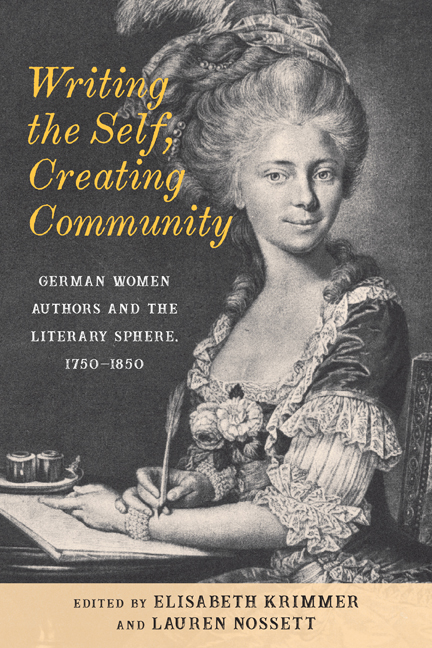Book contents
- Frontmatter
- Contents
- Acknowledgments
- Introduction
- Part I Writing a Community
- 1 Empowering Germany’s Daughters: On the Pedagogical Program and the Poetic Techniques of Sophie von La Roche
- 2 “Ich spreche lieber von guten Büchern”: Sophie von La Roche’s Concept of Female Authorship and Readership
- 3 Challenging Female Ideals: Marie-Elisabeth de La Fite’s Translation of Sophie von La Roche’s Geschichte des Fräuleins von Sternheim
- 4 Catherine II, Polyxene Büsching, and Johanna Charlotte Unzer: A Literary “Community of Practice”
- Part II Writing the Self
- 5 Ghostwriters: The Apparitional Author in Benedikte Naubert’s “Die Weiße Frau” (1792) and Sophie Albrecht’s Das Höfliche Gespenst (1797)
- 6 Vampirism Inverted: Pathology, Gender, and Authorship in Karoline von Günderrode’s “Die Bande der Liebe”
- 7 Wozu eine Amazonen—Literatur? Literary Creativity and Productivity in the Writings of Helmina von Chézy
- 8 Women Writers and the Märchenoma: Foremother, Identity, and Legacy
- Part III Writing toward Emancipation
- 9 The Illegitimacy of Authorship and the Legitimization of Passion in Agnes von Lilien
- 10 The Politics of the Female Body in Louise Aston’s and Fanny Lewald’s Writings through the Prism of the Romantic Theory of Sociability and Dialogue
- 11 Weibliche Irrsterne: Louise Otto and the Notion of Female Genius in Nineteenth-Century Germany
- Bibliography
- Notes on the Contributors
- Index
1 - Empowering Germany’s Daughters: On the Pedagogical Program and the Poetic Techniques of Sophie von La Roche
Published online by Cambridge University Press: 01 October 2020
- Frontmatter
- Contents
- Acknowledgments
- Introduction
- Part I Writing a Community
- 1 Empowering Germany’s Daughters: On the Pedagogical Program and the Poetic Techniques of Sophie von La Roche
- 2 “Ich spreche lieber von guten Büchern”: Sophie von La Roche’s Concept of Female Authorship and Readership
- 3 Challenging Female Ideals: Marie-Elisabeth de La Fite’s Translation of Sophie von La Roche’s Geschichte des Fräuleins von Sternheim
- 4 Catherine II, Polyxene Büsching, and Johanna Charlotte Unzer: A Literary “Community of Practice”
- Part II Writing the Self
- 5 Ghostwriters: The Apparitional Author in Benedikte Naubert’s “Die Weiße Frau” (1792) and Sophie Albrecht’s Das Höfliche Gespenst (1797)
- 6 Vampirism Inverted: Pathology, Gender, and Authorship in Karoline von Günderrode’s “Die Bande der Liebe”
- 7 Wozu eine Amazonen—Literatur? Literary Creativity and Productivity in the Writings of Helmina von Chézy
- 8 Women Writers and the Märchenoma: Foremother, Identity, and Legacy
- Part III Writing toward Emancipation
- 9 The Illegitimacy of Authorship and the Legitimization of Passion in Agnes von Lilien
- 10 The Politics of the Female Body in Louise Aston’s and Fanny Lewald’s Writings through the Prism of the Romantic Theory of Sociability and Dialogue
- 11 Weibliche Irrsterne: Louise Otto and the Notion of Female Genius in Nineteenth-Century Germany
- Bibliography
- Notes on the Contributors
- Index
Summary
IN 1783, SOPHIE VON LA ROCHE began editing the journal Pomona, which explicitly addressed a female audience. In the preface, she confidently refers to her own gender:
Das Magazin für Frauenzimmer und das Jahrbuch der Denkwürdigkeiten für das schöne Geschlecht—zeigen meinen Leserinnen, was teutsche Männer uns nützlich und gefällig achten. Pomona—wird Ihnen sagen, was ich als Frau dafür halte.
[The Magazine for Women and the Yearbook of Memorable Matters for the Fair Sex—show my readers what German men find useful and pleasing for us. Pomona—will tell you what I as a woman consider worthy of attention.]
Even though many eighteenth-century women authors chose to remain anonymous, some did publish under their own names or used gender markers in anonymously published texts, as, for instance, Ruth Dawson has emphasized. Yet in these introductory words to Pomona, Sophie von La Roche not only highlights her gender but positions her writing against the predominant male discourse. Up until now, she says, men in public media have explained to a female audience what they consider “useful and pleasing” (prodesse et delectare) for women. Now a female editor of a journal is raising her voice and offers her readers her own selection of useful and entertaining literature. This self-confident point of view was made possible by a changing environment.
Moral weekly or monthly journals were among the most important media in the eighteenth century for disseminating knowledge, literature, and skills in a range of areas, as evidenced by an increase in the number of publications over the course of the century. Between 1730 and 1740, 176 journals were founded; between 1741 and 1765, 754; and between 1766 and 1791, 2,191. The overwhelming majority of these journals were composed and edited by men. Only a small number—Ulrike Weckel counts 14—were composed by women. Sophie von La Roche was one of the first women to publish a journal and to address a primarily female audience. In an age without an established school system and without universal education requirements, journals offered women an important avenue for increasing their knowledge and for reading for pleasure.
- Type
- Chapter
- Information
- Writing the Self, Creating CommunityGerman Women Authors and the Literary Sphere, 1750–1850, pp. 22 - 43Publisher: Boydell & BrewerPrint publication year: 2020



